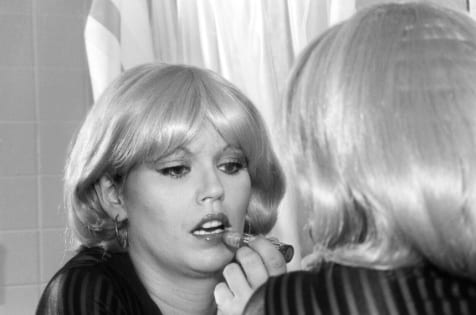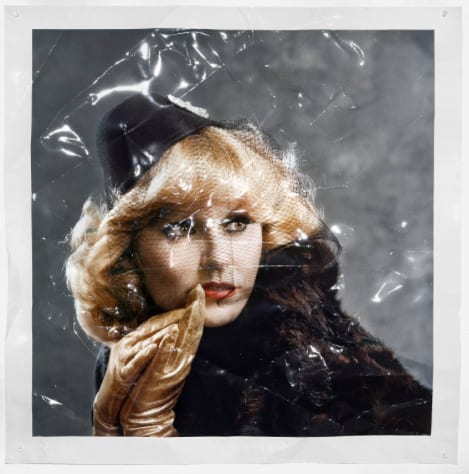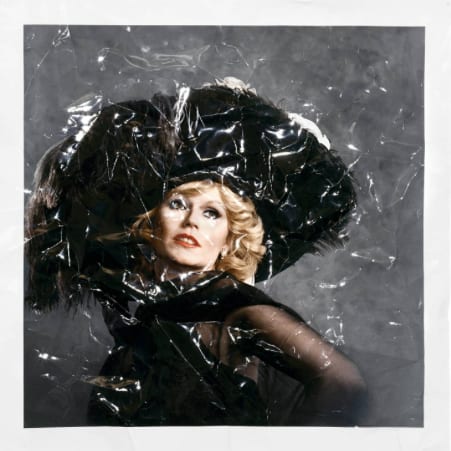Zoe Crosher celebrates Los Angeles in her work- the illusion of stardom, the ability to reinvent oneself and the discrepancy between fact and fiction in a city built upon illusion. The Michelle duBois Project began in 2005 and continues to evolve with the persona of Michelle duBois, a relic of an extensive photo archive and the protagonist that we follow in Crosher’s larger narrative. As a native Angeleno I related to Crosher’s thoughtful responses of the influence of the LA environment in her work and I thought it would be fitting to include a portion of her response here:
“I am obsessed with Los Angeles and its inability to comprehend its own past, or even acknowledge that it has one. What I like about Los Angeles is that it exists primarily in its own state of imaginary – that it is more inspired by what is written about it, whispered about it, how it is photographed, how it filmed, how it is forgotten, how it is promised over what it actually is (very much in line with the problem of photography!) This provides for an incredible amount of freedom, it is a place where people go to escape, forget or redefine themselves, and therein lives a potential for liberation from all sorts of constraints and potentially, real creativity.”

Why did you decide to pursue your artistic practice on the West Coast?
It was an interesting moment after I graduated with my MFA from CalArts in 2001, when NYC still held sway over the art world and LA was viewed as a bit of a backwater when it came to the arts. For that summer, I was lucky enough to simultaneously housesit at a brownstone in Carroll Gardens and a one-bedroom on Houston & 6th Avenue, and so given that and armed with some meager savings (what was left of my student loan) I decided to take a chance and see if NYC was where I needed to be – which is pretty much where everybody said I needed to be if I wanted to have a proper career.
It was a wild summer, hot and humid, filled with all sorts of romance that is unique to the time before 9/11. I floated around the art scene, made all sorts of new and short-term friends, managed to drink more (complimentary drinks flowed everywhere in the art world then) than during my entire sojourn at undergraduate and graduate school. I learned that NYC meant business and that it moved at a rate I had never before experienced, watched money flow in a way I had never imagined, explored the Italian side of Brooklyn, ate those crazy icy orange thingies, tried to recover from a broken engagement, learned the G train and the whole time did not produce one piece of art. Or almost event think about art. About a month before 9/11, I woke up and realized that after two months I had nothing more to show than a substantial social schedule of names I couldn’t match up with faces, and a much lighter purse that was not backed up with a trust fund, and that it was time to return to LA.
Which couldn’t have been more lucky, really, as I was staying above a firehouse, which lost half of its firefighters during the September 11th attacks. I was also lucky returning to Los Angeles at that moment as Afterall was looking for an editorial assistant, which was a post that opened up the next chapter in my art world life…

Why not New York?
During that fated summer I realized that New York is there when you are ready to mean and do business, that it is a perfect place to be when you are honed for attack. Being there at that time was a critical lesson in learning the various roles that exist in the art world, to understand that it is a system that I was just one part of, that it has all these other arms with all different intentions and motivations, and that it wasn’t just about the work.
Because at that time I was idealistic (well, I still am, but it has been tapered by years of survival training), and very much into making and creating without understanding the larger scheme of things, i.e. the market. I was very young, only 25 turning 26, and trying to figure out how or where I could fit. And I couldn’t seem to find my way in NYC then, I wasn’t ready for it. And those friends of mine who had moved there were working these horrendous jobs, partying all night, commuting into the far depths of Brooklyn (which was not so fancy then) barely able to afford a quarter of a studio to work in – just none of it felt right to me beyond the immediacy of some sort of lived excitement, it didn’t translate into anything beyond that. And the truth is, I’ve never been able to stay up very late, even when I was in college, so that burned out my partying circuit after a certain point. So there I was, realizing I couldn’t keep up with the lifestyle that was demanded by a young, poor artist and that NYC wasn’t inspiring the work, and that I actually could live in Los Angeles and pay $500 in rent for a small apartment in Silver Lake (those were the days!) and $300 a month for a studio, and figure out a way to actually make work and not just be a slave to working for others.

What do you find distracting about your urban environment?
The New York urban environment is impossible for me to create in as there is simply too much noise, in every possible way. To make work, and this is something that probably was learned during Michael Asher’s infamous post-studio course at CalArts, is that it takes time to think about and make good work, even pushed to a certain of boredom perhaps. To really make new ground, one needs to go beyond what one knows, and it one is constantly fighting and reacting to one’s environment, it is very hard to hear what the real questions are, the real concerns, and the real work. There is truly no time to make work in NYC for me, let alone getting into conversations about the practical realities of everyday living (i.e. IKEA on the subway, etc.) That said, I have higher quality conversations in a much shorter period of time whenever I am actually in NYC and engage in such an animated way that I do find inspiration in there in that regard. New York lives on chance happenings and circumstance, of bumping into people on the train, on the street, finding oneself at two parties they didn’t know about a couple hours earlier – there is a spontaneity to existence there that is without compare to me, even in Europe. And that distraction is a welcome one, and on that is sorely missed here in LA, where EVERYTHING is planned and nothing, I’m afraid, happens at random. Well, perhaps it is all so random it goes beyond random, but I do find myself always planning the route in a way that lessens the immediacy and excitement of any event. Getting anywhere is like pulling teeth, and as I am a private person who likes being in the garden, it’s tough to get me out sometimes, even if I am truly happy once I get there. Regarding the distraction of the urban environment here in LA, it is just that – losing so much time to anxiety about the planning and getting around that often times I don’t make half the social obligations I want to because I am too caught up trying to get out my front door. And forget driving between 4 & 7pm anywhere in this city! I have fallen in love with public radio, for better or worse.

What feature do you feel is unique to your city?
I am obsessed with Los Angeles and its inability to comprehend its own past, or even acknowledge that it has one. The History of Forgetting by Norman Klein is still like a bible, although a now dated late 90s version of it, before all sorts of cosmopolitan things started happening here. What I like about Los Angeles is that it exists primarily in its own state of imaginary – that it is more inspired by what is written about it, whispered about it, how it is photographed, how it filmed, how it is forgotten, how it is promised over what it actually is (very much in line with the problem of photography!) This provides for an incredible amount of freedom, it is a place where people go to escape, forget or redefine themselves, and therein lives a potential for liberation from all sorts of constraints and potentially, real creativity. There is a line I always use – “I could disappear into the Valley and become a death-metal yogini who hula hoops” and this is actually true, I really could do this if the spirit moved me, which is quite incredible if you think about it.
The other feature that is unique to this city is that it has so many art schools with so many fantastic artists experimenting and making work. And although it is nowhere near as affordable as it used to be, there are still ways to make it happen. What is exciting is that the writers, curators and dealers are starting catch on, and there is a new wave of people coming into the city who can reimagine the next wave of art in Los Angeles, smart people, motivated and professional people, and this is exciting to me as they are raising the bar. Good collectors, however, seem to be mainly rooted in NYC – there is not enough financial support of artists here at that kind of level, but who knows, perhaps this can change. There certainly is enough money floating around this town to make that happen.
What do you find most appealing about New York?
What I stated above – the spontaneity and unknowingness of what might happen to you on any given day, whether good or bad.

What artists have influenced your practice the most?
Different artists have had profound effects on me at different moments in my growth, so who was super inspiring to me in college (Cindy Sherman) is very different than when I was in grad school (Michael Asher, Richard Prince) than who inspires me now. Recently I have been obsessed with reenactment and keep coming back to Pierre Huyghe, who is an endless source of inspiration, along with a film by Jeremy Deller called the Battle of Orgreave. Other moments: seeing a painting by Lucy McKenzie at Metro Pictures that still blows me away and that I think of all the time, her working collaboration with Paulina Olowska, walking into Yayoi Kusama’s firefly installation when no one knew what it was and which was in the gallery in an unmarked trailer, having to wait in a short line to see it alone (and being annoyed at first for having to do so…) what a lady called Lauren Mackler is doing here in Los Angeles called Public Fiction, a young artist also here called Daniel Small who is working on this amazing excavation of the Ten Commandments movie site that is being unearthed by the winds somewhere in Southern California, the CLUI & Museum of Jurassic Technology, the first place I visited when I came to LA to look at grad schools. Eve Babitz’s forgotten writings, any artist who writes, Hans Peter Feldman (who deserves a major retrospective here in Los Angeles), the way James Welling moves through the art world, inspiring and supporting younger artists, the Words Without Pictures project, spearheaded by Charlotte Cotton and Alex Klein at LACMA, LACMA in general right now, Scott Benzel’s audio prowess, Mark Hagen’s additive paintings, Liz Glynn’s sense of history, Shana Lutker’s gentle hand, Sarah Cain’s love and fearlessness of scale, Shirana Shahbazi’s installation at MoMA up now at New Photography, I could go on. But I generally tend towards work that activates in some sense – that is both conceptually and aesthetically inspired and rigorous, that somehow goes beyond the edge of whatever frame or border, in all senses.
THE 20+20 PHOTOGRAPHY ISSUE
Zoe Crosher is featured within Installation Magazine’s special 20+20 Photography Issue, which highlighted 20 Los Angeles and 20 New York City photographers. Download the full issue on your iPad and iPhone.
